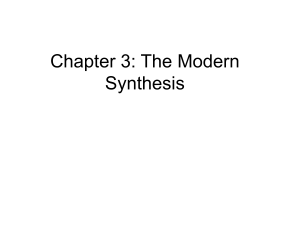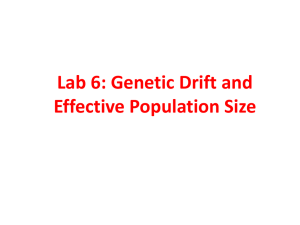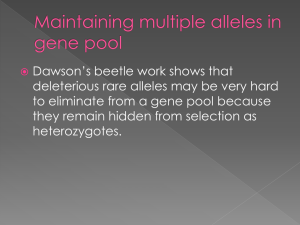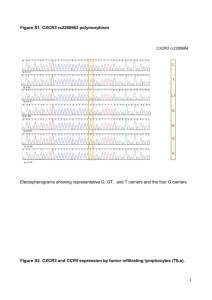Matt
advertisement
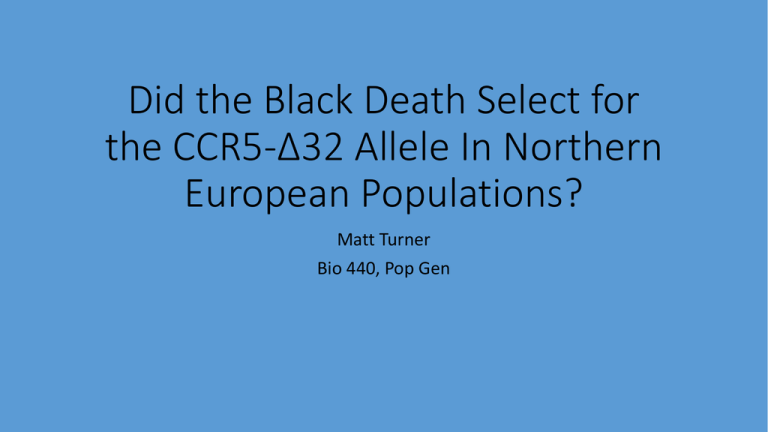
Did the Black Death Select for the CCR5-Δ32 Allele In Northern European Populations? Matt Turner Bio 440, Pop Gen Abstract CCR5 is a protein that acts as a co-receptor on the surface of leukocytes, and is thus a recognition site for the HIV virus. However, individuals possessing the CCR5-Δ32 allele, a 32 base-pair deletion in the CCR5 genome that causes a frameshift mutation and results in a non-functional protein, have dramatically increased resistance to HIV infection. This allele is almost exclusively found within Northern European populations, and shows evidence that it reached its current frequency in these populations not through genetic drift, but through an extremely powerful selective force. Various researchers have pointed to the Black Death, the 1346-1352 epidemic that killed millions, as the possible selective pressure that pushed the CCR5-Δ32 allele to its current frequencies today. However, this theory is being increasingly challenged by mathematical models, current CCR5-Δ32 allele frequencies in populations hit especially hard by the Black Death, and by various experiments. This evidence shows that the Black Death is likely not the selective pressure responsible for the high frequencies of the CCR5-Δ32 allele in Northern European populations. Smallpox has been proposed as a possible alternative, but little evidence supports this and more research is required in this field. Introduction • The HIV/AIDS epidemic has killed millions across the globe in recent decades. The HIV virus works by directly targeting the immune system by recognizing the protein co-receptors that lie on the surface of leukocytes. • However, a mutation in the CCR5 co-receptor has been found to be linked to increased resistance to HIV. In the CCR5-Δ32 allele of this co-receptor, there has been a 32 basepair deletion, resulting in a frameshift mutation and preventing the CCR5 co-receptor from appearing on the leukocyte’s surface (Zimmerman et al. 1996, Samson et al. 1997, Victoria et al. 1998). • Populations with a high frequency of this allele are thus far less vulnerable to the HIV/AIDS epidemic. CCR5-Δ32 Allele Frequencies • Nearly 10% of Europeans possess this allele, but the CCR5-Δ32 allele is vastly more concentrated in Northern European populations (Galvani and Slatkin 2003). • This allele is practically exclusive to Caucasians –in multiple studies, researchers were unable to detect even a single example of this allele in various Asian, Pacific Islander, African, and Native American populations (Yudin et al. 1998, Yuanan et al. 1999). • This has led researchers to believe that this mutation had a single, relatively recent origin, only within the last 4000 years or so (Samson et al. 1996, Libert et al. 1997). (Novembre et al. 2005) Possible Explanations • The CCR5-Δ32 allele currently appears to be in Hardy-Weinberg equilibrium, and appears to neither increase or reduce the fitness of individuals homozygous or heterozygous for it (Martinson et al. 1997). While it does confer a selective advantage against HIV, the HIV/AIDS epidemic hasn’t yet had a chance to affect the allele’s HardyWeinberg equilibrium within Northern European populations yet. • The recent origin of the mutation and its current high frequencies among Northern European populations make genetic drift an unlikely explanation for the null allele’s current prevalence (Stephens et al. 1998, Kalev et al. 2000, Duncan et al. 2005) • This makes it likely that the allele was previously under some sort of selective pressure, one no longer prevalent due to the allele’s current state of genetic equilibrium. The Black Death (Monty Python) (Bos et al. 2011) Did the Black Death Select for the CCR5-Δ32 Allele? • Scientists quickly concluded that the CCR5 null allele was likely selected for during the Black Death (Stephens et al. 1998) a massive epidemic that swept through Asia and Europe from 1346 to 1352, killing anywhere from a third to half of Europe’s population (Bos et al. 2011). • Scientists reached this conclusion by reasoning that CCR5-Δ32 likely confers resistance to Yersinia pestis, which directly attacks macrophages of the immune system in a similar manner to HIV (Stephens et al. 1998). (Bos et al. 2011) (Zimmerman et al. 1996) Criticisms of the Black Death Theory • A 2003 mathematical study concluded that, even with the massive loss of life the epidemic caused, it still didn’t generate nearly enough selective pressure to account for current CCR5-Δ32 frequencies in Northern European populations, even when researchers worked under the assumption that the CCR5-Δ32 allele is dominant (Galvani and Slatkin 2003). • Even when the researchers factored in the selective pressures of 400 years of subsequent outbreaks of bubonic plague, it still wasn’t enough to drive the allele to current frequencies. (Galvani and Slatkin 2003) More Criticisms of the Black Death Theory Mediterranean areas were hit by the Black Death much harder than Northern European countries and thus would’ve had even higher selective pressure for the null allele. However, the Mediterranean island of Malta, which had been under Norman control since 1127, giving Vikings and other Northern Europeans plenty of time to introduce the allele into the population before the Black Death hit, currently has almost no examples of the CCR5-Δ32 allele. Out of 300 thirdgeneration Maltese citizens, researchers were only able to find a single homozygote individual (Baron and Schembri-Wismayer 2010). This strongly suggests that the CCR5-Δ32 allele historically offered very little, if any, protection against the plague. Even More Criticisms of the Black Death Theory • In a 2004 study, scientists found that mice with a deficient CCR5 coreceptor had no more resistance to Yersinia pestis than mice with a normally functioning co-receptor (Prentice et al. 2004). While the CCR5Δ32 allele may have a slightly different effect in humans, this strongly implies that the Black Death is not the historical selective pressure that researchers have been looking for. • However, smallpox has recently been proposed as a possible alternative –it has been dated to at least 2,000 years ago and had a much more continuous mortality throughout European history, working through constant background mortality instead of in massive sweeping epidemics (Galvani and Slatkin 2003). In several mathematical models, researchers proved that only approximately 1,135 years of smallpox epidemics were required for the CCR5-Δ32 allele to reach its current frequency within European populations. (Galvani and Slatkin 2003) Conclusion Although studies confirming the increased resistance of the CCR5-Δ32 allele to HIV have existed since 1996 (Samson et al. 1996), scientists still do not know very much about this mutation, particularly why it exists almost exclusively in Northern European populations and how it rose to prominence so quickly. The Black Death, due to the mounting evidence, is likely not the historical selective pressure responsible for this allele’s prominence. While it is likely that smallpox may be the real reason why, little evidence aside from mathematical models currently supports this. More research is definitely required in this field. References • Literature Cited • Baron B, Schembri-Wismayer P. 2010. Using the distribution of the CCR5-Δ32 allele in third-generation Maltese citizens to disprove the Black Death hypothesis. Int J Immunogenet. 38(2):139-143. • Bos KI, Schuenemann VJ, Golding GB, Burbano HA, Waglechner N, Coombes BK, McPhee JB, DeWitte SN, Meyer M, Schmedes S, Wood J, Earn DD, Herring DA, Bauer P, Poinar HN, Krause J. 2011. A draft genome of Yersinia pestis from victims of the Black Death. Nature. 478(1):506-510. • Duncan SR, Scott S, Duncan CJ. 2005. Reappraisal of the historical selective pressures for the CCR5-Δ32 mutation. J Med Genet. 42(1):205-208. • Galvani AP, Slatkin M. 2003. Evaluating plague and smallpox as historical selective pressures for the CCR5-Δ32 HIV-resistance allele. Proc Natl Acad Sci U.S.A. 100(25):276-279. • Haensch S, Bianucci R, Signoli M, Rajerison M, Schultz M, Kacki S, Vermunt M, Weston DA, Hurst D, Achtman M, Carniel E, Bramanti B. 2010. Distinct clones of Yersinia pestis caused the Black Death. PLoS Pathog. 6(10):4-10. • Kalev A, Mikelsaar V, Beckman L, Tasa G, Pärlist P. 2000. High frequency of the HIV-1 protective CCR5 Δ32 deletion in native Estonians. Eur J Epidemiol. 16(1):1107-1109. • Libert F, Cochaux P, Beckman G, Samson M, Aksenova M, Cao A, Cziezel A, Claustres M, Ferrari M, Ferrec C, Glover G, Grinde B, Güran S, Kucinskas V, Lavinha J, Mercier B, Ogur G, Peltonen L, Rosatelli C, Schwartz M, Spitsyn V, Timar L, Beckman L, Parmentier M, Vassart G. 1997. The Δccr5 mutation conferring protection against HIV-1 in Caucasian populations has a single and recent origin in Northeastern Europe. Hum Mol Gen. 7(3):399-406. • Martinson JJ, Chapman NH, Rees DC, Liu YT, Clegg JB. 1997. Global distribution of the CCR5 gene 32-basepair deletion. Nat Genet. 16(1):100-103. • Mecsas J, Franklin G, Kuziel WA, Brubaker RR, Falkow S, Mosier DE. 2004. Evolutionary genetics: CCR5 mutation and plague protection. Nature. 427(1):606. • Novembre J, Galvani AP, Slatkin M. 2005. The geographic spread of the CCR5 Δ32 HIV-resistance allele. PLoS Biol. 3(11):339. • Prentice MB, Gilbert T, Cooper A. 2004. Was the Black Death caused by Yersinia pestis? Lancet Infect Dis. 4(2):72. • Samson M, Libert F, Doranz BJ, Rucker J, Liesnard C, Farber CM, Saragosti S, Lapouméroulie C, Cognaux J, Forceille C, Muyldermans G, Verhofstede C, Burtonboy G, Georges M, Imai T, Rana S, Yi Y, Smyth RJ, Collman RG, Doms RW, Vassart G, Parmentier M. 1996. Resistance to HIV-1 infection in Caucasian individuals bearing mutant alleles of the CCR-5 chemokine receptor gene. Nature. 382(1):722-755. • Smith MW, Dean M, Carrington M, Winkler C, Huttley GA, Lomb DA, Goedert JJ, O’Brien TR, Jacobson LP, Kaslow R, Buchbinder S, Vittinghoff E, Vlahov D, Hoots K, Hilgartner MW. 1997. Contrasting genetic influence of CCR2 and CCR5 variants on HIV-1 Infection and disease progression. Science 277(1):959-965. • Stephens JC, Reich DE, Goldstein DB, Shin HD, Smith MW, Carrington M, Winkler C, Huttley GA, Allikmets R, Schriml L, Gerrard B, Malasky M, Ramos MD, Morlot S, Tzetis M, Oddoux C, Giovine FS, Nasioulas G, Chandler D, Aseev M, Hanson M, Kalaydjieva L, Glavac D, Gasparini P, Kanavakis E, Claustres M, Kambouris M, Ostrer H, Gordon D, Baranov V. 1998. Dating the origin of the CCR5-Δ32 AIDS-resistance allele by the coalescence of haplotypes. Am J Hum Genet. 62(6):507-515. • Victoria A, López-Larrea C, Coto E. 1998. Mutational analysis of the CCR5 and CXCR4 genes (HIV-1 co-receptors) in resistance to HIV-1 infection and AIDS development among intravenous drug users. Hum Genet. 102(1):483-486. • Yuanan L, Nerurkar VR, Dashwood WM, Woodward CL, Ablan S, Shikuma CM, Grandinetti A, Chang H, Nguyen HT, Wu Z, Yamamura Y, Boto WO, Merriwether A, Kurata T, Detels R, Yanagihara R. 1999. Genotype and allele frequency of a 32-base pair deletion mutation in the CCR5 gene in various ethnic groups: Absence of mutation among asians and pacific islanders. Int J Infect Dis. 3(4):186-191. • Yudin NS, Sergey VV, Potapova TA Naykova TM, Sitnikova VV, Kulikov IV, Khasnulin VI, Konchuk C, Vloschinskii PE, Inavov SV, Kobzev VF, Romaschenko AG, Voevoda MI. 1998. Hum Genet. 102(6):695-698. • Zimmerman PA, Buckler-White A, Alkhatib G, Spalding T, Kubofcik J, Combadiere C, Weissman D, Cohen O, Rubbert A, Lam G, Vaccarezza M, Kennedy PE, Kumaraswami V, Giorgi JV, Delets R, Hunter J, Chopek M, Berger EA, Fauci AS, Nutman TB, Murphy PM. 1997. Inherited resistance to HIV-1 conferred by an inactivating mutation in CC chemokine receptor 5: studies in populations with contrasting clinical phenotypes, defined racial background, and quantified risk. Mol Med. 3(1):23-36.

